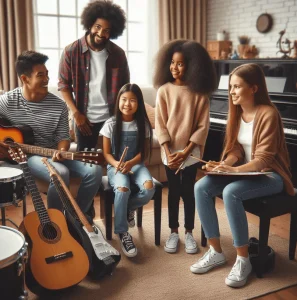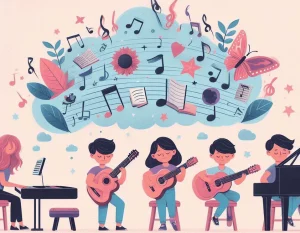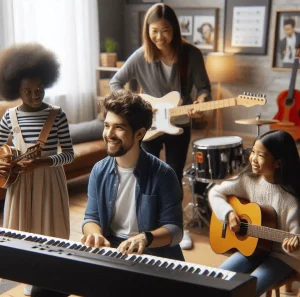Engineering in and For the Instrumental Music Classroom

Audio schooling, in some kind, goes back again as significantly as training by itself. When in some cases battling for legitimacy, it even so has experienced its champions. Additional not too long ago, as technological innovation has flourished within just instruction, technological applications made exclusively for the educating of tunes have been created. Although much of this technologies is developed generally for the classroom there are plans created for the scholar to use in the house, albeit restricted to people college students with a property pc and world-wide-web accessibility.
The instructing of new music in the American instructional location dates back 1838 when Lowell Mason introduced singing classes to Boston grammar educational facilities. Instrumental music appeared in suits and begins about the subsequent fifty a long time but was under no circumstances bundled during the faculty working day alternatively, it was relegated to the ranks of extracurricular things to do. All-around the switch of the century, instrumental tunes started to see some acceptance into the classroom, nevertheless usually was taught by those people untrained in the region of songs training. Moreover, small if any standardization of the instrumentation or audio literature existed. (Rhodes, 2007)
In the vicinity of the summary of Earth War I the top quality of school songs commenced to increase. This was because of mostly to veterans who, right after getting been musically educated in the numerous services branches, began to fill tunes training positions in the universities. Band, nonetheless, was however regarded as an extracurricular activity. (Ibid)
In 1907, the Music Supervisors Countrywide Conference or MSNC, (now acknowledged as the Songs Educators Nationwide Conference or MENC) was organized to assist faculty songs. In 1912 a proposal was made to include things like, as accredited topics, a amount of tunes routines including choruses and standard music. Band was provided – but at a a lot decrease precedence. Later, on the other hand, at the Cleveland MSNC convention in 1923, Edgar B. Gordon mentioned,
“The higher faculty band is no for a longer time an incidental school business prompted mainly by the volunteer expert services of a higher university instructor who comes about to have had some band expertise, but somewhat an undertaking which is assigned to a definite area in the college plan with a every day class time period below a educated instructor and with credit history permitted for satisfactory function carried out.” (Ibid)
In the similar 12 months, and probable because of to the maximize in each acceptance and great importance, Carl Greenleaf (then head of C. G. Conn Ltd.) served organize the first National Band Contest in Chicago. Later on, in 1928, he directed the Conn business to lead to the founding of the Countrywide Songs Camp in Interlochen, Michigan and later supported publications intended to assist band administrators. Though these endeavors may have appeared somewhat self-serving in mild of his situation with Conn, they however assisted establish college band as a major component of faculty curriculum. (Banks, 1997)
Irrespective of a gradual, even though nevertheless restricted, acceptance of instrumental new music inside of the school curriculum, price range cuts have often curtailed or even removed these systems. Further, with the latest increased emphasis on “teaching to the exam” because of to the pressures of No Boy or girl Still left Behind (NCLB) and identical state necessities, help for the inclusion of music in schools has started to wane. Michelle R. Davis, in “Instruction Week,” mentioned “The federal No Youngster Left Powering Act is prompting lots of universities to slice back again on subjects such as social reports, new music, and artwork to make far more time for examining and mathematics…” (Davis, 2006) This is most unlucky thinking about that the review of music, especially instrumental new music, has proved to be useful for all learners – even raising their ability to rationale and difficulty-address.
Many theorists have contributed to the elevation of audio as central to instruction, or at the really least, shown that restricting the university natural environment to the “A few R’s” is shorter-sighted. Howard Gardner postulated his “Many Intelligences” idea with the knowing that little ones do not have similar propensities for mastering. Not only do they have differing capacities for understanding but have differing capacities for mastering in several parts. These locations, as he discussed, are the different intelligences of which he speaks. Originally describing 7 intelligences (of which tunes is highlighted) he recognized two especially (linguistic and rational-mathematical) as “the ones that have generally been valued in university.” (Gardner, 1999, p41) Clearly, Gardner regarded that the academic process was not achieving all learners – only those people that could “do school” properly. Gardner did not limit his analyze, of training course, to the mere existence of several intelligences but shown that a provided person can be powerful in more than 1, enabling these intelligences to interact a single with the other. He stated that, “there are other approaches in which distinctive intelligences can have an effect on just about every other…one particular intelligence can mediate and constrain the many others a single intelligence can compensate for a further and just one intelligence can catalyze an additional.” (Gardner 2, 2006, p219) He further extolled the benefits of a musical intelligence by outlining that “…a strong musical intelligence might lead a particular person engaged in a linguistic undertaking to be much more sensitive to the rhythmic homes of language as perfectly as its which means.” (Ibid, p223)
Whilst quite a few might believe that new music and the study thereof is associated generally to that which is heard, it is also similar quite carefully to arithmetic. Dahlhaus, reflecting Rameau mentioned that “songs had its origins in the Pythagorean proportions (i.e., audio is a arithmetic).” (Gargarian, 1996, p137, 138) Regardless of regardless of whether or not a single agrees with the theory that tunes is mathematical in toto, there should really be tiny dispute as to the relativity of songs notation to arithmetic. Indeed, introducing the coordinate, or Cartesian, plane appears to assist the new new music scholar in knowing the horizontal (x), and vertical (y) axes of songs notation. Just mentioned, the horizontal (x) axis on the songs staff members relates to length although the vertical (y) axis relates to pitch. This, of course is a reflection upon Gardner’s aforementioned theory of intelligence interaction.
There is further proof that instrumental new music research is beneficial for the scholar. In 1995, Gottfried Schlaug, et al, posted a study, “Increased Corpus Callosum Measurement in Musicians” whereby they explained an enhance in neural fibers throughout the Corpus Callosum (CC), contributing to its enlargement. They further more were able to ascertain that this improve in fibers/CC size was attributable to instrumental tunes research. (Schlaug, et al, 1995) Definitely, the supposition can effortlessly be made that, if there is greater cross-talk amongst the two hemispheres of the brain (specially, the remaining – believed to be the analytical, and the appropriate – thought to be the inventive) the final result would be a human being with a better, extra innovative, dilemma-fixing ability.
Reflecting upon Gardner’s theories, as nicely as individuals of Schlaug, et al, it really should shock no one that others have verified backlinks amongst audio and other skills. Bahr and Christiansen in their report “Inter-Area Transfer Between Mathematical Skill and Musicianship” printed results demonstrating that learners who experienced analyzed new music shown top-quality effectiveness on mathematical duties furnished there was some structural overlap with tunes. (Bahr, Christiansen, 2000) This “structural overlap” could be virtually something, which includes the romance of dividing measures or notes into fractions, relating pitch to frequency, or, as aforementioned, setting up the connection involving the coordinate (Cartesian) aircraft and the new music staff members.
With this improved challenge-resolving capability this greater consciousness of mathematical concepts, it would not be a grand leap to think that audio learners could possibly perform effectively with classroom technology. Indeed, music pupils should be anticipated to do at least as properly as other learners with regard to technological know-how. If that is legitimate, then the following step would be to presume that they would do primarily effectively with technology geared in particular to them.
Considerably lately, technologists, recognizing a dearth of technologically-based mostly new music purposes began to build computer plans for tunes education. Tunes concept websites began to seem, quite a few obtaining been made by, and joined to, symphonic businesses. Other people have been produced by lecturers and graduate students both as component of coursework or probably for their possess use (and anybody wishing to make use of the application). A speedy research of the web reveals that there are pretty a number of offered technological equipment created and published for the songs pupil. There are interactive new music game titles, in-course keyboard songs concept purposes, countless on the net pitch and rhythm internet sites, and, potentially most impressive, apps identified as “computer system assisted instruction” (CAI)” particularly for the audio classroom and student. In January 2005, Steven Estrella printed the results of a examine demonstrating how new music lecturers in the U.S. utilised audio technologies. Amongst his conclusions, he found that approximately 20 per cent of the survey individuals utilized some variety of CAI as aspect of their instruction. The study additional found that the predominant program software was “SmartMusic.” (Estrella, 2005)
SmartMusic is a teacher/university student interactive software enabling learners to observe, at residence, with a synthesized band or orchestral accompaniment. The program can also, with an included microphone, record the student’s efforts and quality them employing rhythm and pitch information. The university student can instantly see their success and can retry if they wish. The recording and the accompanying quality are then emailed to the student’s instructor/director and instantly entered into the teacher’s database quality guide. The plan includes accompaniments for around 30-thousand compositions including band and orchestra strategy e book parts. (Nagel, 2007) Even though early assessments of the software had been blended, the corporation that produces SmartMusic, “MakeMusic,” was evidently responsive to trainer/customer problems and suggestions. The plan needs that the home variation be set up on the college students individual personal computer and, in earlier versions, set up, setup, and microphone placement had been problematic. In the hottest version, SmartMusic 11, numerous of these troubles have been tackled both by simplifying the method or with enhanced user guides. (Whaley, 2008)
For the classroom, SmartMusic holds a wealth of apps. The most fundamental capabilities of the system involve a exhibited tuner and metronome. (A audio classroom with an interactive whiteboard can make outstanding use of SmartMusic’s utilities.) The teacher can then participate in a pre-recorded model of a piece to be analyzed and, while the students are actively playing together, can immediately record them unbiased of the pre-recording for later on playback. The application also includes fingering charts for all devices so a brief test for the learners perhaps needing supplemental instruction is effortlessly attained. Keys and tempi can be modified conveniently, if important, and if a solitary performer wishes to participate in with a pre-recorded accompaniment, that accompaniment, “listening” to the performer through a microphone, can observe the performer’s changes in tempo – not as opposed to what the conductor of a symphony orchestra would do in a are living functionality.
As significant and potent as SmartMusic is in the classroom, its most effective application – and the major goal for which it was meant – is that of a property exercise and assessment resource. There are virtually thousands of accompaniments and scales included in the software program as perfectly as hundreds of tunes titles. The moment the students have subscribed, downloaded (or mounted from a CD), and established up the house model of the method, the instructor can style participating in assignments which the pupil then accesses at dwelling on their possess personal computer.
Participating in via a microphone to the program’s accompaniment gives an immediate visible and aural response although the recording of the student’s general performance is performed, their suitable notes are shown in inexperienced though issues are shown in crimson. The university student can make a decision on and established their own tempo, then exercise with the laptop or computer-created accompaniment as several moments as they desire prior to recording for a quality. In shorter, the university student is in handle although at home. Pupils acquiring obtain to broadband world wide web and a moderately up-to-day laptop can completely know the possible of the system – as effectively as their possess. (Rudolph, 2006)
But what of those college students not fortuitous sufficient to have a personal computer at property – allow by yourself web obtain?
Of course, the energy of SmartMusic would be mostly shed on individuals students without a house pc or internet access. The charge of the property version is small, and some districts have even offered the subscription free of demand for their students. (Nagel, 2007) However, can districts deliver a workable computer system and world-wide-web access or all of its pupils?
David Thomas said that faculties have built fantastic progress in the introduction of laptop and net entry. However, that entry, for disadvantaged students, remains at college. (Thomas, 2003) Thomas further quoted then U. S. Secretary of Instruction, Rod Paige:
“We have to have to address the restricted access to technologies that several pupils have outside the house of school. There is substantially extra we can do. Closing the digital divide will also enable near the achievement hole that exists in our educational facilities.” (Thomas, 2003)
A 2007 analyze in New York uncovered that involving seventy and eighty p.c of pupils have pcs at property. (Traber, 2007) A single could possibly advise that the genuine quantities cross-country are truly considerably reduce.
There are lots of music pupils dependent upon college-delivered devices, system books, and even instrument materials this sort of as reeds and valve oil (generally provided out the teacher’s possess pocket). These learners are now at the rear of their extra affluent counterparts and can not afford private lessons, let alone a workable personal computer and world-wide-web accessibility. These are the pupils who could advantage most from a method these types of SmartMusic. Nonetheless, as beneficial and impressive as SmartMusic is, it simply cannot by by itself bridge this “electronic divide” that nevertheless exists.
Instructional technology holds great guarantee for the pupil musician but until finally a process for equitable obtain is found out, disproportionate achievement will persist.
References
Bahr, N. & Christensen C.A. (2000). Inter-Domain Transfer Between Mathematical Ability and Musicianship. In Journal of Structural Learning & Intelligent units (Vol. 14(3), 2000, pp. 187 – 197). US: Gordon & Breach Science Publishers
Banking institutions, Margaret Downie (1997). A Short History of the Conn Business (1874-current). The Countrywide Audio Museum.
Davis, Michelle R. (2006, April). Review: NCLB Leads to Cuts for Some Topics. Instruction 7 days.
Estrella, Steven (2005). Study of Music Educators and New music Technologies. Shearspire.
Gardner, Howard (1999). Intelligence Reframed, A number of Intelligences for the 20 Initially Century. Simple Publications/Perseus Books Group: New York
Gardner, Howard (2006). Numerous Intelligences – New Horizons. Simple Guides/Perseus Publications Group: New York
Gargarian, Gregory (1996). The Art of Design and style. In Kafai, Y., & Resnick, M. (Eds.). Constructionism in observe: planning, pondering, and mastering in a electronic planet. Mahwah, NJ: Lawrence Erlbaum Associates
Nagel, Dave (2007, August). Tucson USD Presents SmartMusic Subscriptions to Students, THE Journal.
Rhodes, Stephen L. (2007). A History of the Wind Band – The American University Band Movement. Lipscomb College.
Rudolph, Tom (2006, February). The Broad Planet of SmartMusic. Tunes Instruction Engineering.
Schlaug, Gottfried Lutz, Jäncke Huang, Yanxiong Staiger, Jochen F., Steinmetz, Helmuth, (1995). Enhanced Corpus Callosum Dimension in Musicians. Neuropsychologia, Vol. 33, No. 8, pp. 1047-1055, Retrieved June 19, 2008 from http://www.musicianbrain.com/papers/Schlaug_CCallosum_1995b.pdf
Thomas, David (2003). Online Obtain Soars in Educational institutions, But “Digital Divide” Continue to Exists at Property for Minority and Very poor College students. U. S. Division of Instruction.
Traber, Chris (2007, September). Weak Students Struggle In Class. YorkRegion.com News.
Whaley, Roger (2008, September 10). SmartMusic 11! – MakeMusic has launched SmartMusic 11!. The Band Ed Device Shed (Weblog).




